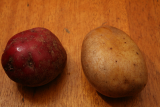Green fruits and leaves contain steroidal glycoalkaloids such as soladulcidine, solanine, solasodine, chaconine etc., saponins.
Wink, M. (2009). Mode of Action and toxicology of plant toxins and poisonous plants. Mitt. Julius Kuhn-Inst. 421:93-111.
Class Ib-II poison - highly to moderately poisonus - disturbance of GI tract, vomiting, spasms, internal bleeding, salivation, trembling, restlessness, headache, delirium, fever and coma. In severe cases death may occur through respiratory arrest.
Wink, M. (2009). Mode of Action and toxicology of plant toxins and poisonous plants. Mitt. Julius Kuhn-Inst. 421:93-111.
Alkaloids in green potatoes can be toxic to the GI tract. They are 'Class Ib-II poison - highly to moderately poisonus - disturbance of GI tract, vomiting, spasms, internal bleeding, salivation, trembling, restlessness, headache, delirium, fever and coma. In severe cases death may occur through respiratory arrest.'
Professor Anthony Dayan, 2022
